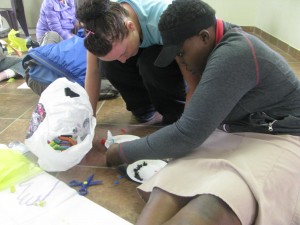Looking at feelings of animals and the challenges we face
 Today we worked again at Letaba school. Today in our 2 groups we were looking at feelings and animals and trying to adapt our aims to children with different spectrums of disabilities. This has proved a challenging task and one that we are continuing to develop as we go along.
Today we worked again at Letaba school. Today in our 2 groups we were looking at feelings and animals and trying to adapt our aims to children with different spectrums of disabilities. This has proved a challenging task and one that we are continuing to develop as we go along.
This has proved a challenging project due to the disabilities and also the language barrier and understandings of the children’s needs. Many of the children have disabilities that have not been diagnosed and whom have very challenging behaviour. Nevertheless our volunteers are doing a fantastic job helping to bring the activities together with the children.
Both groups worked very well with the children, touching on feelings which was a difficult subject and challenge for us to focus on with the  different needs of each child. The sensory group made monkey paper plate puppets, and they all drew happy faces on one side and a sad face on the otherside. Lucy and Ruth put on some masks and did some monkey acting and impressions in the circle with different noises and scenarios. Mia then helped the children to turn their plates around to tell us if they thought the monkeys looked ‘happy’ or ‘sad’. The aim of this was not to find out how the children were feeling, but to look at recognizing feelings. This was important as we did not want to stir up or uncover any feelings that the children have inside them, due to the
different needs of each child. The sensory group made monkey paper plate puppets, and they all drew happy faces on one side and a sad face on the otherside. Lucy and Ruth put on some masks and did some monkey acting and impressions in the circle with different noises and scenarios. Mia then helped the children to turn their plates around to tell us if they thought the monkeys looked ‘happy’ or ‘sad’. The aim of this was not to find out how the children were feeling, but to look at recognizing feelings. This was important as we did not want to stir up or uncover any feelings that the children have inside them, due to the  nature of their traumas, as we are aware that this could cause more harm than good to them if not supported
nature of their traumas, as we are aware that this could cause more harm than good to them if not supported  consistently by the right professionals who work in therapy.
consistently by the right professionals who work in therapy.
They also included a lot of singing and music in their sessions which the children appear to respond very positively towards.
The other group looked at making friends, making hands on a board of each of the children, and looking at feeling happy when animals are with their friends, allowing the more able bodied children to use their own ideas in. Some of the extra children in this group that join us regularly even when they are not scheduled to come into the group also partake in the activities, but have very different needs to the other children, which is another challenge for the team.Their work looked beautiful as they also used colours to express different feelings.
When working with the children in groups of around 10-15 children, with 6 volunteers in each group, we begin to get a feel of the frustration that the teachers have when they are teaching the children. As we recognise throughout our time, the very different needs of all of the children, we try to combine different activities for different levels of ages and abilities focusing on difficult subjects such as feelings of animals. Those volunteers whom have worked in the UK in their own jobs with children with disabilities, are used to working one to one with a child, also knowing beforehand their abilities and emotional needs. A big part of our work is observations of the children which we have been asked to do for the teachers who are trying hard to understand some of the children that they do not get to spend a lot of time with. The children we work with have been selected as those that have higher emotional and/or physical needs. This also helps us realise that our previous work experience can hopefully be beneficial for the teachers as well as the children.
Children have their own minds and when making and planning activities, you have to have many different ones, which the volunteers have to pre-plan , but improvise at the same time.
We were all pleased about how the day went, and were happy about the activities that we did with the children. We will now look forward to developing them further.
By Roger Mallins, August 13, 2010 @ 11:29 am
Well done everyone ,superb reading!